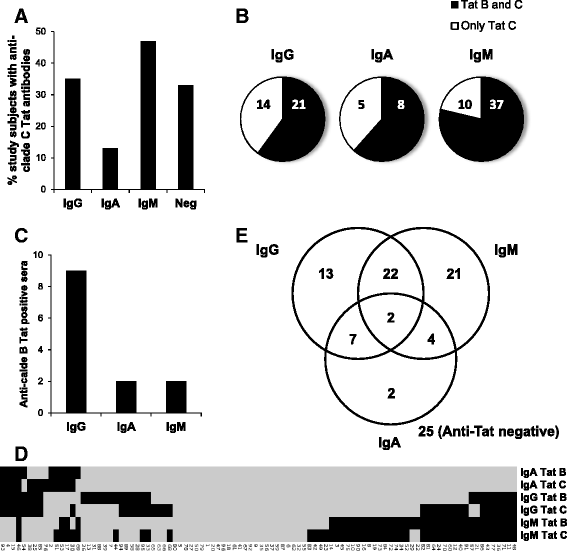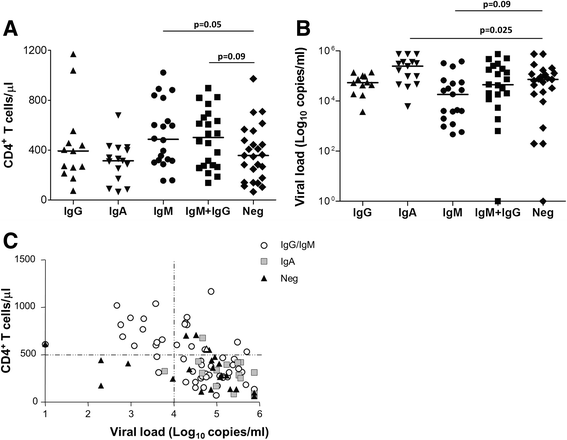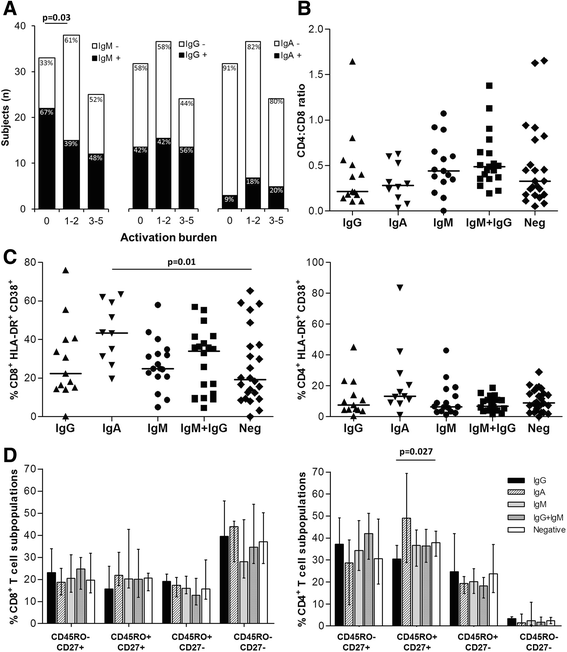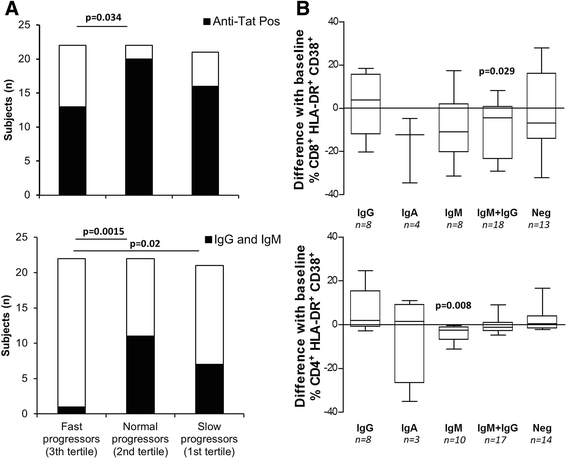Association between different anti-Tat antibody isotypes and HIV disease progression: data from an African cohort
- PMID: 27450538
- PMCID: PMC4957276
- DOI: 10.1186/s12879-016-1647-3
Association between different anti-Tat antibody isotypes and HIV disease progression: data from an African cohort
Abstract
Background: The presence of IgG and IgM against Tat, an HIV protein important for viral replication and immune dysfunction, is associated with slow disease progression in clade B HIV-infected individuals. However, although Tat activities strictly depend on the viral clade, our knowledge about the importance of anti-Tat antibodies in non-clade B HIV infection is poor. The objective of this study was to investigate the association of different anti-Tat antibody isotypes with disease progression in non-clade B HIV-infected subjects and to study the relationship between anti-Tat humoral responses and immunological abnormalities.
Methods: Anti-clade B and -clade C Tat IgG, IgM and IgA titers were assessed in serum samples from 96 cART-naïve subjects with chronic HIV infection from Mbeya, Tanzania, and associated with CD4(+) T cell count, plasma viremia and CD4(+) and CD8(+) T cell phenotypes.
Results: Anti-Tat IgM were preferentially detected in chronic HIV-infected subjects with low T cell activation (p-value = 0.03) and correlated with higher CD4(+) T cell counts and lower viral loads irrespective of the duration of infection (p-value = 0.019 and p-value = 0.037 respectively). Conversely, anti-Tat IgA were preferentially detected in individuals with low CD4(+) T cell counts and high viral load (p-value = 0.02 and p-value < 0.001 respectively). The simultaneous presence of anti-Tat IgG and IgM protected from fast CD4(+) T cell decline (p-value < 0.01) and accumulation of CD38(+)HLADR(+)CD8(+) T cells (p- value = 0.029).
Conclusions: Anti-Tat IgG alone are not protective in non-clade B infected subjects, unless concomitant with IgM, suggesting a protective role of persistent anti-Tat IgM irrespective of the infecting clade.
Keywords: Antibodies; Clade B HIV; Clade C HIV; Diseases progression; Immune activation; Tat.
Figures




Similar articles
-
HIV-Tat immunization induces cross-clade neutralizing antibodies and CD4(+) T cell increases in antiretroviral-treated South African volunteers: a randomized phase II clinical trial.Retrovirology. 2016 Jun 9;13(1):34. doi: 10.1186/s12977-016-0261-1. Retrovirology. 2016. PMID: 27277839 Free PMC article. Clinical Trial.
-
Anti-Tat immunity defines CD4+ T-cell dynamics in people living with HIV on long-term cART.EBioMedicine. 2021 Apr;66:103306. doi: 10.1016/j.ebiom.2021.103306. Epub 2021 Apr 7. EBioMedicine. 2021. PMID: 33839064 Free PMC article.
-
Plasma levels of viro-immunological markers in HIV-infected and non-infected Ethiopians: correlation with cell surface activation markers.Clin Immunol. 2001 Feb;98(2):212-9. doi: 10.1006/clim.2000.4958. Clin Immunol. 2001. PMID: 11161977
-
HIV and inflammation.Curr HIV Res. 2005 Jul;3(3):243-59. doi: 10.2174/1570162054368057. Curr HIV Res. 2005. PMID: 16022656 Review.
-
"cART intensification by the HIV-1 Tat B clade vaccine: progress to phase III efficacy studies".Expert Rev Vaccines. 2018 Feb;17(2):115-126. doi: 10.1080/14760584.2018.1418666. Epub 2017 Dec 22. Expert Rev Vaccines. 2018. PMID: 29243498 Review.
Cited by
-
Age-related decline of de novo T cell responsiveness as a cause of COVID-19 severity.Geroscience. 2020 Aug;42(4):1015-1019. doi: 10.1007/s11357-020-00217-w. Epub 2020 Jun 24. Geroscience. 2020. PMID: 32583231 Free PMC article. No abstract available.
-
The Tat Protein of HIV-1 Prevents the Loss of HSV-Specific Memory Adaptive Responses and Favors the Control of Viral Reactivation.Vaccines (Basel). 2020 Jun 4;8(2):274. doi: 10.3390/vaccines8020274. Vaccines (Basel). 2020. PMID: 32512757 Free PMC article.
-
A child with perinatal HIV infection and long-term sustained virological control following antiretroviral treatment cessation.Nat Commun. 2019 Jan 24;10(1):412. doi: 10.1038/s41467-019-08311-0. Nat Commun. 2019. PMID: 30679439 Free PMC article.
-
Antiretroviral therapy initiated during acute infection in women with HIV-1 clade C reduces anti-Tat antibody production and lowers CD8+ T cell activation.Front Immunol. 2025 Jun 18;16:1564960. doi: 10.3389/fimmu.2025.1564960. eCollection 2025. Front Immunol. 2025. PMID: 40607402 Free PMC article.
-
Impaired Priming of SARS-CoV-2-Specific Naive CD8+ T Cells in Older Subjects.Front Immunol. 2021 Jul 13;12:693054. doi: 10.3389/fimmu.2021.693054. eCollection 2021. Front Immunol. 2021. PMID: 34326844 Free PMC article.
References
-
- Zauli G, Gibellini D, Celeghini C, Mischiati C, Bassini A, La Placa M, et al. Pleiotropic effects of immobilized versus soluble recombinant HIV-1 Tat protein on CD3-mediated activation, induction of apoptosis, and HIV-1 long terminal repeat transactivation in purified CD4+ T lymphocytes. J Immunol. 1996;157(5):2216–2224. - PubMed
-
- Secchiero P, Zella D, Capitani S, Gallo RC, Zauli G. Extracellular HIV-1 tat protein up-regulates the expression of surface CXC-chemokine receptor 4 in resting CD4+ T cells. J Immunol. 1999;162(4):2427–2431. - PubMed
-
- Monini P, Cafaro A, Srivastava IK, Moretti S, Sharma VA, Andreini C, et al. HIV-1 Tat promotes integrin-mediated HIV transmission to dendritic cells by binding Env spikes and competes neutralization by anti-HIV antibodies. PLoS One. 2012;7(11):e48781. doi: 10.1371/journal.pone.0048781. - DOI - PMC - PubMed
MeSH terms
Substances
LinkOut - more resources
Full Text Sources
Other Literature Sources
Medical
Research Materials
Miscellaneous

